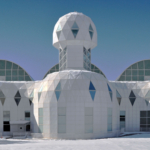Excerpt
The novelist and essayist Amitav Ghosh argues this about the relationship between planetary calamity and the literary form known as the novel: “it was exactly in the period in which human activity was changing the earth’s atmosphere that the literary imagination became radically centered on the human. Inasmuch as the nonhuman was written about at all, it was not within the mansion of serious fiction but rather in the outhouses to which science fiction and fantasy had been banished.” [1] Despite the value Ghosh places on “serious” genres of the novel associated with realism and modernism, he concludes that the enormity and complexity of global warming demands new and “hybrid” forms of storytelling. [2] Along these lines, environmental humanists have sought to identify genres of fiction that have emerged in response to climate change—a growing list that includes “postnatural fiction,” “novels of the Anthropocene,” and “CliFi”.[3] This nascent canon runs the gamut, from novels that intermix scientifically-driven plots with fantastical ecology to post-apocalyptic tales of rising seas, prolonged droughts, food insecurity, and extinction. [. . . .] The plots of these bestsellers riff on the Anthropocene, a term coined in 2000 by scientists Paul J. Crutzen and Eugene F. Stoermer, who originally proposed the term as the epoch to succeed the current Holocene by demarcating anthropogenic climate change as a distinct chapter in geological time. [4] While the International Union of Geological Sciences has been deliberating for two decades whether officially to adopt the Anthropocene, the concept has gained traction as a cultural and academic keyword, one that also has inspired manifold critique for reinforcing Eurocentric ideas of nature and for papering over the unequal causes and consequences of global warming.
The newness of literary fictions identified with new environmental frameworks is debatable. [. . . .] This is not to discount the social significance or literary caliber of recent novels that tackle what Ghosh terms the “unthinkable” realities of climate change, but to broaden the scope of narrative analysis within the environmental humanities. [. . . .] Adopting this expansive approach to environmental narrativity, the purview of this essay is not the question of how—or how inventively—literary fiction currently engages with planetary crises. Rather, [this essay] directs critical attention to stories taking shape outside imaginative literature and that imagine the Anthropocene as an occasion to expand on, rather than repair or dismantle, its economic and technological regimes. Flying under the radar of scholarship and activism alike, authors using this narrative template—whose leitmotif is making rather than saving nature—jettison established “varieties of environmentalism” while lauding technological acts of inventing, designing, and rebuilding biophysical worlds. [5] To develop this argument, I begin by sketching the parallel emergence of a high-tech planet and a planet in peril as divergent narratives of global capitalism. I then turn to two visions of remaking the planet through high technology: geoengineering and terraforming. These overlapping arenas for gigantic-scale engineering draw an expressly environmental portrait of innovation that imbues the tech industry with quasi-magical capacities alternately to improve on and to transcend the Anthropocene. Offering a counterpoint to this techno-utopia, I conclude with a discussion of Karen Tei Yamashita’s novel Through the Arc of the Rainforest (1990), which satirizes the colonial logic of such world-building fantasies while making the planet a charismatic character with a story of its own.
[1] Ghosh, The Great Derangement, 66.
[2] Ibid, 84.
[3] For discussions of CliFi (or climate fiction), see Abraham, “CliFi”; LeMenager, “The Humanities,“ 460-4; Ramuglia, “Cli-fi,” 154-64; Sullivan, “Material Ecocriticism,” 401-2; Taylor, “The Novel after Nature,” 108-17; and Tuhus-Dubrow, ‘Cli-Fi,” 58-60. The term postnatural fiction comes from Levin, “Contemporary Ecofiction”; while “Novels of the Anthropocene” is attributed to Marshall, “What are.”
[4] Crutzen and Stoermer, “The ‘Anthropocene,’” 17.
[5] Guha and Martinez-Alier, Varieties of Environmentalism.


